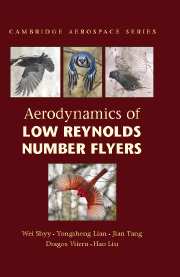4 - Flapping-Wing Aerodynamics
Published online by Cambridge University Press: 05 July 2009
Summary
Flying animals flap wings to create lift and thrust as well as to perform remarkable maneuvers with rapid accelerations and decelerations. Insects, bats, and birds provide illuminating examples of utilizing unsteady aerodynamics to design future MAVs.
Pioneering work on flapping-wing aerodynamics was done by Lighthill (1969) and Weis-Fogh (1973). Recent works, both in experiments and simulations, were documented by Katz (1979), Ellington (1984a), DeLaurier (1993), Smith (1996), Vest and Katz (1996), Liu and Kawachi (1998), Dickinson et al. (1999), Jones and Platzer (1999, 2003), Wang (2000), and Chasman and Chakravarthy (2001). A review of the characteristics of both flapping wings and fixed wings was given by Shyy et al. (1999a). The spectrum of animal flight with flapping wing was presented by Templin (2000). Ho et al. (2003) further reviewed the recent effort in developing flapping-wing-based MAVs. Computational and experimental studies regarding rotating-wing MAVs were made by Bohorquez et al. (2003).
Aerodynamic phenomena associated with biological flight prominently features unsteady motions, characterized by large-scale vortex structures, complex flapping kinematics, and flexible-wing structures. Furthermore, knowledge gained from studying biological flight shows that the steady-state aerodynamic theory can be seriously challenged to explain the lift needed for biological flyers
(Brodsky, 1994; Ellington, 1984a; Ellington et al., 1996).The quasi-steady theory is constructed based on the instantaneous velocity, wing geometry, and AoA when the steady-state aerodynamic model is used.
- Type
- Chapter
- Information
- Aerodynamics of Low Reynolds Number Flyers , pp. 101 - 158Publisher: Cambridge University PressPrint publication year: 2007
- 10
- Cited by



